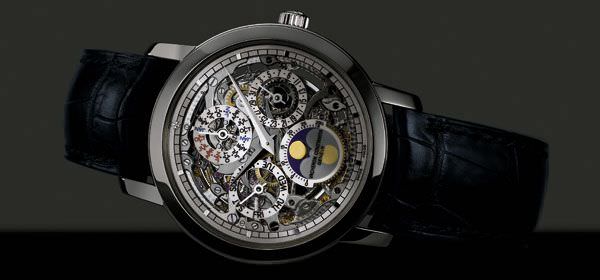In describing its Patrimony collection, Vacheron Constantin uses a musical metaphor, comparing it to an orchestra leader who makes an outstanding musical masterpiece of the past come alive under the movement of his baton. If, as the proverb says, ‘comparisons are not always good,’ it does seem in the present case, however, to be totally justified. In fact, in both its ‘Traditionnelle’ version and its ‘Contemporaine’ version, Vacheron Constantin proposes a form of watchmaking that is timelessly classic, one that could be qualified as a ‘reference’ in the same way we would speak of a reference work, while at the same time it has been re-interpreted, in a very subtle manner, to satisfy today’s taste.

If the Patrimony Contemporaine line, with its purity and refinement, represents the brand’s ultra-thin movements, then the Patrimony Traditionnelle revisits the codes of traditional timekeeping: the round case with its tiered horns, a fine bezel knurling around the case back, dials in silvered tones with dauphine hands, facetted trapezoidal hour markers, and a screw-in sapphire crystal case back.
In bringing traditional watchmaking into the present, Vacheron Constantin is demonstrating its merit as a manufacture, both in terms of the most advanced refinement, as exemplified by the Patrimony Traditionnelle Automatique, as well as in the art of the complication, as seen in the Patrimony Traditionnelle ‘Calibre 2755’, which also combines a Tourbillon Minute Repeater with a Perpetual Calendar. It is also evocative of the brand’s prowess in the art of engraving and openwork as is showcased in the Patrimony Traditionnelle Skeleton Perpetual Calendar.
Architecture of light
Rather than a simple ‘skeleton’ (based on an existing movement), the architecture of the Patrimony Traditionnelle Skeleton Perpetual Calendar was specially designed right from the beginning to give an airy and open approach, thus showing off the functions and indications of the movement. This achievement is the fruit of intense collaboration between the master watchmaker and the master engraver. To use the term ‘architecture’ is not merely gratuitous, since the inspiration, whether in the type of the construction itself — the form of the bridges, the layout of the movement — or in terms of the engraving and decoration, is drawn from the same source: the Eiffel Tower, a monument to engineering as well as being a masterpiece of the Art Nouveau era.
This inspiration is particularly evident on the back of the watch where the engraver has more surface area to delicately reproduce the rich motifs, to scale, that decorate the ‘lace of steel’ of the Parisian tower.
On the front of the watch, the dial, with its transparent sapphire crystal set on a silvered ring that integrates the applied indices and the dial train, has a double function. It allows for perfect readability of the time and the date while also offering a profound view into the open-worked movement. Traced on the dial, the indications of the perpetual calendar thus seem larger and more visible, leaving space for the subtle marks of the lunar phases composed of two discs under an unpolished glass.
At the crossroads of tradition and modernity, the exceptional timepiece is made in 950 platinum or 18 carat rose gold and is equipped with the latest generation of mechanical movement. Developed by the manufacture, this calibre has an oscillating weight with ceramic ball bearings that do not require any lubrication.
As expected, the Patrimony Traditionnelle Skeleton Perpetual Calendar has earned the Geneva Seal. It also features a diameter of 39 mm, water-resistance to 30 metres, an alligator mississipiensis leather bracelet, and a classic buckle.
Source: Europa Star August-September 2007 Magazine Issue





